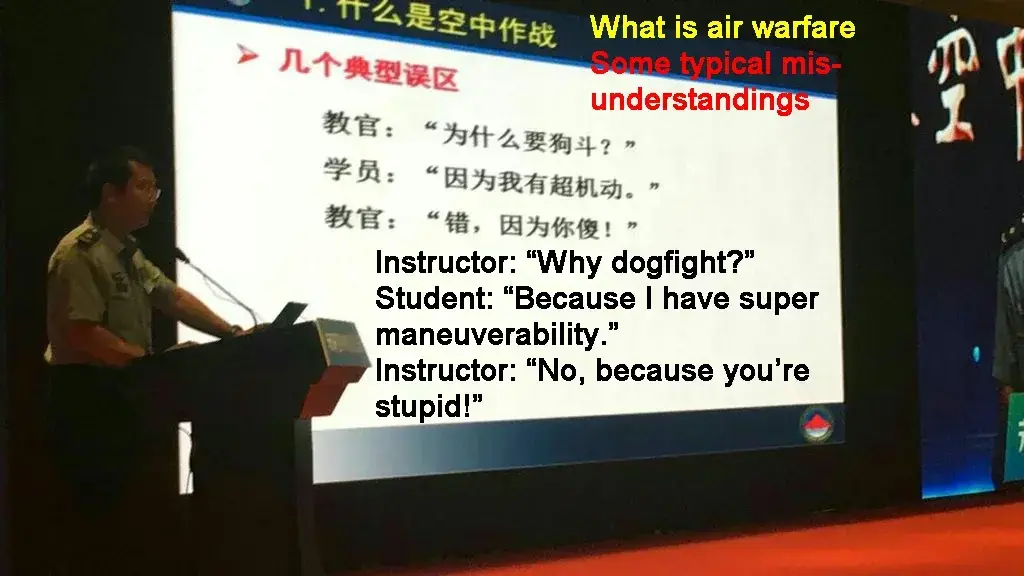new detection method: study
Hell yeah studying wins again
“I can’t see anything, sir.”
“…study…”
“Oh, shit, there it is! I see it like 60,000x better now.”
I don’t think this work is even that surprising, which is perhaps the surprising part to most people. Fusing information from a network of radars has always been the Achilles heel of stealth aircraft. It’s just that radar fusion at a country-level scale hadn’t really been demonstrated before.
The US is openly talking about the networking capabilities of the F-35 and other aircraft, I would expect that they simply don’t/didn’t want to publicize they had radar fusion. The US is hands-down the most advanced military in the world, so there’s little need to brag about counter-measure capabilities. We brag about our military through offensive dick-measuring. As a result, it’s a double bonus for the Chinese to brag that they’ve neutralized one of our offensive capabilities, because they can’t directly brag about their own offensive abilities.
Why would China want offensive abilities? Their only military engagements in recent history (if you exclude their embassy getting bombed in Serbia) have been fought with sticks and water guns.
Chinese policy has always been domestically-focused.
China wants offensive capabilities because what China considers domestic policy and what other countries consider domestic policy are not always the same thing. See: who is the rightful government of China, or man-made islands to expandf resource claims. Furthermore, offensive capabilities are dual-purpose and can be used to repel invasion. If all you have is defense (like passive armor), then advisories can attach without worrying about counter attack.
I’m sitting here trying to figure out where the Chinese got an F22 to test their study results on.
The US is happy to fly an F-22 around willy nilly in air shows and whatever /s
The real answer is that the J-20’s RCS is probably similar to the F-22 and they realized that the J-20 is vulnerable to this. This has been a known problem with stealth technology for forever, so it’s really more of a deterrence. China really doesn’t want a war, which is why their Navy is so heavily oriented towards coastal (defensive) operations rather than blue water (offensive/power projection) operations.
Sensor fusion is wicked hard though. At the sensor level and the track level it’s a huge pain, especially on something maneuverable.
Engineering problem.
Stealth becomes obsolete
Missile defenses get better
BVR combat becomes basically impossible
Everybody always knows where everybody else is
Sixth generation fighters Retvrn to being purpose-built dogfighters/interceptors
No. Humans in aircraft are on the way out. Drones are the future. When the drones are significantly cheaper than the missiles used to shoot them down, logistics inevitably wins.
its gonna be factories spending all our resources and polluting the planet further just so robots can fight robots, and the robots who win get to slaughter or enslave the civilians.
ww3 is gonna be the dumbest war so far
Oh I never said it would be humans piloting the sixth gen dogfighters. They’re gonna be drones designed to withstand sustained 20G turns to be able to get their guns on target, commanded from something like an AWACS.
They’re gonna be drones designed to withstand sustained 20G turns to be able to get their guns on target
Full Gallente.
Sadly the PLAAF has already made their statement on that…


This is true of current gen air combat, but I’m speculating about a future where dogfighting once again becomes the only way to achieve air superiority.
It’s like in dune and other things where they have shields against guns so they have to use blades again
The pure “Nah bitch WE losin” energy of the shield detonation problem is beautiful to behold
The article is stealth too. Only the first paragraph is detectable.
https://archive.is/4LbGN is right in the description man. Also, Hexbear users can’t read posts from World.
Xie’s team said it had overcome this long-standing engineering challenge. The researchers said their “smart resource scheduling” method allowed a centralised networking radar system to adjust beam parameters and the power of each radar based on the characteristics and real-time positional changes of stealth aircraft in the theatre.
This allowed the system to focus its limited detection resources on the most exposed azimuth, or angle of arrival, of the stealth fighter, significantly enhancing the intensity and tracking accuracy of its radar signature while ensuring it is continuously locked on to the target.
Pretty cool stuff, it’s really the backend and reliability they need to implement.
US aircraft actually already do this where multiple radars from multiple aircraft can be auto coordinated to increase range and resolution, possibly via link 16.
Sounds like the solution to overcome this is to send two F22s. All their radars will be focusing on the first one it’ll be easier for the second to go by undetected.
This guy stealths
Wait no
The short excerpt suggests this, yes
But spoiler alert: they too will have thought about that.
They are just able to detect an aircraft that’s near end of life, it’s likely they have not been able to counter two aircraft.
More radars for more planes
it’s not that complicated
At the end of the day, this is a defensive innovation. While the US has a limited supply of F-22s, China has an essentially infinite supply of radar installations.
They don’t have an infinite supply of radar installations.
They are only just able to detect the aircraft at the end of its life.
The US can produce more f35s than china can produce radar installations. This aircraft is still in mass production, with many more being built and sold to many nations. Which likely can’t be detected. If they could then that would be in the announcement.
It’s a bigger deal to detect the newer and more widely available aircraft that can be launched from aircraft carriers. The F22 is an interceptor, primarily for defense. So it’s less likely to be used where multiple hostile radar installations are in range.
All this effort to identify a stealth aircraft first developed in 1996
I don’t know which is more impressive, the tech the US military had 28 years ago, or the amount of engineering time china had spent on spotting a jet that has seen limited use and is being replaced by an even newer stealth jet.
I mean 1996 is still reasonably new 🤷♂️ I wouldn’t disregard this achievement as easily as you do. Especially since this is just the research that is released to the public. If they can do this it is not without doubt that they have even more capabilities they’re not sharing openly.
The newer jet is more or less shittier than F22
It’s not as purpose-built, but its replacing a ton of airframes which are decidedly not as stealthy as an F22. Think of all of the F16s, F18s, and AV-8s being replaced by F35s
adjust beam parameters and the power of each radar based on the characteristics and real-time positional changes of stealth aircraft in the theatre.
So uh… That sounds like they have to know where it is in order to detect it on radar.
Why would they publish this information?
probably as a future deterrent, to avoid major conflict - that they are
boomingbecoming more and more formidable opponent and should not be taken lightly.This. The realpolitik purpose of showing your death and anti-death toys is always at least a little about “don’t fuck with us” same way a cigar is usually someone’s mother.
Monke brain still Monke beneath the abstractions.
Paper tiger.
I learn this new term today but I don’t think it fits. May be we can look at the Korean War as a case study when China intervened (around 1950) - how China changed the course of war just like that, when they were not that well equipped as compared to now.
So formidable… Earlier detection of a severely outdated aircraft that’s being phased out…
deleted by creator
This is why Taiwan advertise everything they have. It’s effectively like being a porcupine, big spikes stick out so you don’t have to role up and take it.
No point keeping secrets ahead of a fight you will no doubt lose if push come to shove. Lay it all out first and hope it’s enough that they think twice before trying.
That’s a great question. Who knows what? Who knows who knows what? Who knows who knows who knows what?
That’s the game.
So the Chinese know where the planes are. The Americans don’t know the Chinese know. The Chinese know the Americans don’t know.
The Chinese publish. Now, the Americans know the Chinese know where the planes are and the Chinese know the Americans know.
This is preferrable to believing the Americans don’t know if they do know. It changes the behavior of military officers.
It is also preferable for the Americans to know as a deterrent against a first strike.
The big question is, if this advantage is worth it, then what else do the Chinese know that the Americans don’t know they know?
Removed by mod
A bluff so easily called is not a bluff at all
Basically they want people to think they’re stronger and that the US is weaker. It’s a PR campaign. The US almost certainly has had the same capability for a while and simply had no need to advertise.
Recognize that the US would be foolish to fly a stealth fighter/bomber within range where multiple radar could lock on. They’d start their attack campaigns from far out and pick off the known ground radar installations at the perimeter, along with downing aircraft that tried to intercept them. After that, the US would have air superiority and only have to worry about mobile radar units. In any case, once they turn the radar on to look for the planes, they’re broadcasting their location and the plane can just launch a missile down their throat.
deleted by creator
Radar detection is not the same as weapons grade lock for anti-aircraft targeting purposes. Still helpful to know something is there, but the article doesn’t provide any additional information on how actionable that information will be.
If you can detect, you can intercept. If you can detect, suddenly a whole host of interception strategies are viable.
Your second sentence is mostly accurate, your first is not.
Just because tracking radar identifies something, does not mean it’s automatically vulnerable to interception, and it definitely does not guarantee that targeting radar will be able to create a missile, or weapons, lock.
But yes, the ability to track something is a critical first step in an anti-air kill chain.
Your claim is that if I can track something to within 20m, I can’t send a fighter (or multiple) up to engage with it?
No, my assertion is that airspace is very dynamic battlefield.
Just because you can track a possible stealth aircraft several hundred nautical miles off you’re coast, does not guarantee your ability to intercept it with aircraft before it drops it’s payload, or that your SAM sites will be able to get a missile targeting lock.
It’s just a first step.
And this is also true of conventional jet intercepts. Point being, the problem of stealth is basically no longer a problem.
Interceptors haven’t been a thing since the cold war. BVR engagements have been the air to air norm for many years, and that requires a weapons grade targeting lock.
“With this one simple trick, pilots hate him”
So it’s just datalink/sensor fusion? Seems pretty simple if this is all it takes to beat stealth jets.
Well, yeah? always has been















